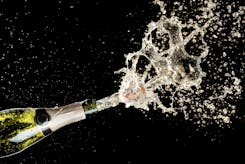- Wine world
How do I open a bottle of Champagne?
- Tue, Aug 27, 2024 at 18:00

Preparation: the ideal Champagne temperature
Before you even touch the bottle, remember that it all starts with the right temperature. Champagne that's too cold can stifle its aromas, while Champagne that's too warm can literally explode when opened. The ideal temperature is between 6 and 8 degrees Celsius. For an even more wow-factor when tasting, sommeliers sometimes recommend moving the bottle from the fridge to the table 15 minutes before opening, so that the aromas begin to release slowly. However, if the bottle has just been transported, we recommend that you let the Champagne rest for half a day. If you're impatient, simply immerse your Champagne for half an hour in a Champagne bucket (half cold water, half ice cubes).
Did you known?
Did you know that Napoleon Bonaparte used to say, “I can't live without Champagne: in victory, I deserve it; in defeat, I need it”? The next time you drink a toast, you'll know you're in good company!
Remove the Champagne cap and snout
The gestures you make when removing the cap and wirehood are not insignificant. The muselet, a small metal cage, was invented in the 19th century to prevent corks from popping out under pressure, a common problem before this innovation. Imagine, in those days, corks were simply tied up with string, causing some pretty festive... and sometimes dangerous incidents!
Advice
When removing the wirehood, always keep a finger on the cork. The pressure in a bottle of Champagne can reach 6 atmospheres, equivalent to the pressure in a truck tire!
The art of sleight of hand: turning the bottle, not the Champagne cork
The key to avoiding splashes: twist the bottle, not the cork. It may seem counter-intuitive, but this technique gives you greater control. What's more, by turning gently, you create a gradual opening that prevents the cork from rocketing off.
Did you known?
During royal ceremonies, it was customary for the butler to open bottles of Champagne in the greatest silence. A discreet “poof” was synonymous with savoir-faire and respect for etiquette, while a loud “pop” was perceived as a lack of mastery.
Champagne service: elegance is in the gesture
Once the cork has been removed, don't neglect serving. Tilt the glass slightly to avoid excessive foaming, and pour slowly. Fill the glass to one-third full, allow the foam to subside, then top up to two-thirds. A good Champagne deserves to be served with the same care and attention that went into making it.
Advice
To impress your guests, you can gently rotate the glass once filled. This rotation releases the aromas and allows you to admire the necklace of bubbles, the ring of foam so characteristic of great Champagnes.
For the adventurous: Champagne sabering
If you're the kind of person who likes spectacular gestures, Champagne sabrage is for you. This method, popularized by Napoleon's hussars after their victories, consists of opening the bottle with a saber stroke. But beware: this is not a technique to be taken lightly. It requires a certain amount of training to avoid injuring yourself or breaking the bottle.
The steps to good Champagne sabrage
Here's how to do it safely:
- Prepare the bottle
Choose a well-chilled bottle of Champagne (4 to 6°C). A chilled bottle reduces internal pressure, making sandblasting easier. Remove the wirehood by unscrewing it, but leave the cork in place.
- Locating the Champagne bottle seam
The Champagne bottle has two seams (mold lines) running from the bottom to the neck. These seams are the weak points of the glass and must be used for sanding.
- Hold the bottle
Hold the bottle by the bottom at an angle of 30 to 45 degrees, pointing the neck away from you and other people.
- Sabre
Place the back of the saber (non-sharp side) on the bottle, in contact with the seam, just below the neck. Slide the saber along the seam in a smooth, rapid upward motion, striking the edge of the neck. The blow must be sharp to break the neck and release the cork.
- Serve
Once the neck has been sandblasted, drip a little Champagne to remove any shards of glass. Then serve with care.
Safety tips
- Never stand in front of the bottle.
- Use a saber specially designed for sabering, or a large, sturdy knife, but never a conventional kitchen knife.
- Always exercise caution, as this method can be dangerous if poorly executed.
Open a bottle of Champagne like a pro
Opening a bottle of Champagne is not just a technical act, it's a moment of sharing and joy. Whether you opt for a traditional opening or a more spectacular sabrage, the most important thing is to enjoy the moment and savor every sip of this beautiful beverage.



